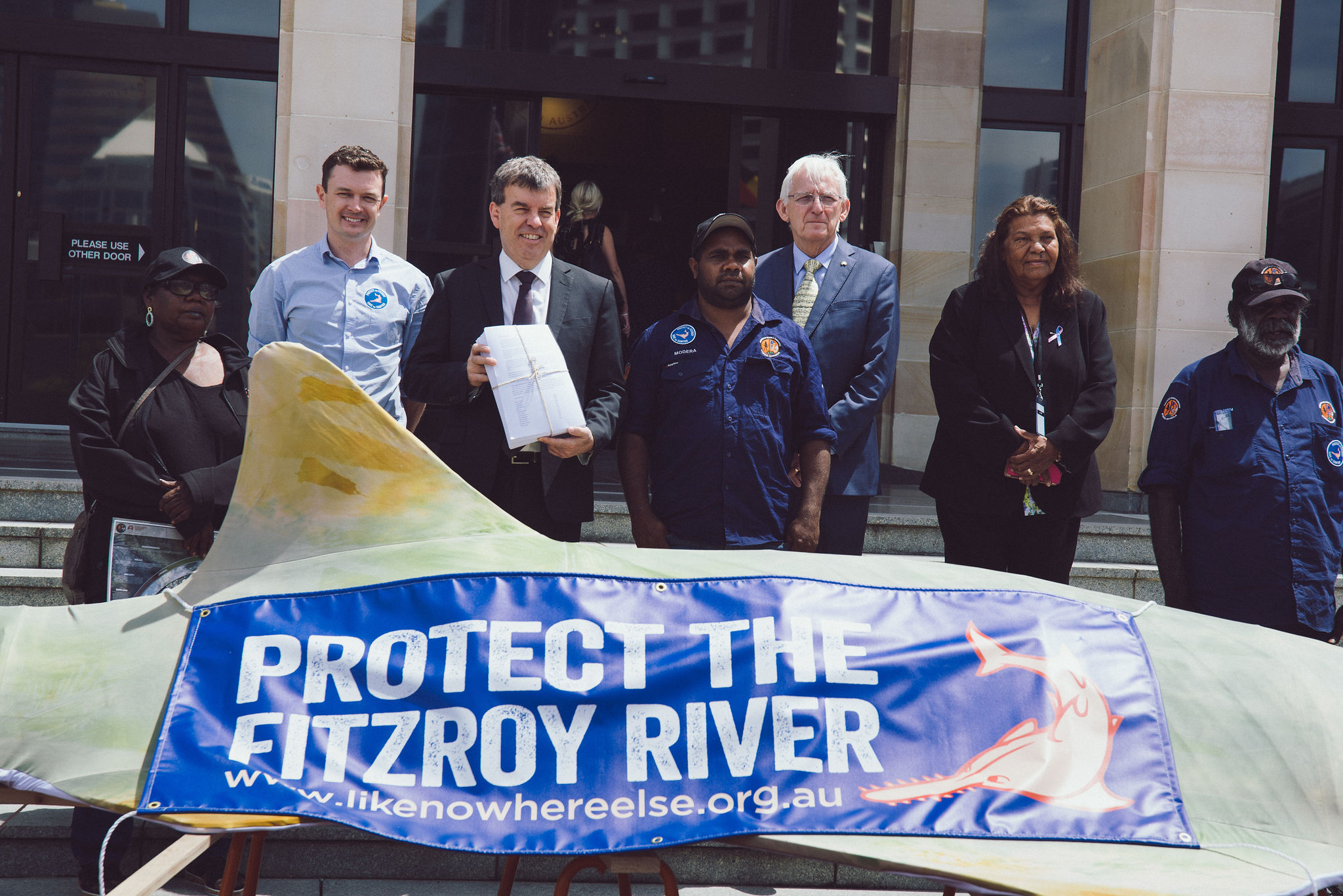A seven-metre long sawfish was produced on the steps of the West Australian parliament by a group of Traditional Owners, conservationists and scientists last week as part of a petition to protect one of the state’s largest rivers.
Nyikina Mangala Traditional Owners from the West Kimberley region delivered a petition containing thousands of signatures demanding the protection of the Fitzroy River, which houses the critically endangered freshwater sawfish.
The WA government is currently considering proposals to irrigate up to 600 gigalitres of surface water from the river to service lucrative agricultural businesses in the region.
The 480 kilometre-long Fitzroy River runs through three different shires: Wyndham-East Kimberley, Halls Creek and Derby-West Kimberley and provides water for more than 60 Aboriginal communities.
Nyikina Mangala Traditional Owner Linda Nardea said Traditional Owners use the river for a number of additional reasons, including for cultural healing.
“I would like to tell the government to protect the river because it’s very important to us, it’s been there for thousands and thousands of years and we’ve been there to look after the river,” Ms Nardea told NITV News.
“It’s there for healing, it meditates us, it’s a good healing for our kids to go out on country.”
William Watson, a Traditional Owner and ranger, said the river provided a lifeline for his people.
“It is like a shopping centre for us … when we are hungry we just go down the river and catch the fish there and what you need, so the river is very important to us, it looks after our animals and our people,” Mr Watson he said. The river is also considered to be the world's last stronghold for the critically endangered freshwater sawfish, which holds cultural significance as a part of a creation story for the Nyikina Mangala people.
The river is also considered to be the world's last stronghold for the critically endangered freshwater sawfish, which holds cultural significance as a part of a creation story for the Nyikina Mangala people.

The WA Water Minister accepted the petition as Kimberley politician, Josie Farrer threw her support behind better protection. Source: Supplied: Kimberley Like Nowhere Else
More than 70 per cent of the sawfish’s natural habitat around the world has disappeared and now the healthiest population of the fish lives in the Fitzroy River.
WA Manager for The Pew Charitable Trusts, Tim Nicol, said the Fitzroy River is critical for the survival of the fish.
“We’re very concerned for the sawfish, and all the animals and people and communities along the river that if you take water out and put in pollution and chemicals, it could have really dire consequences for the river, it’s wildlife and it’s people,” Mr Nicol said at the event.
“The government has promised to protect the river and the health of the river but our message to government is you cant protect the river if you’re taking water out and you’re putting new farms and chemicals close to the river.”
In September, social justice commissioner June Oscar publicly criticised proposals to divert floodwater from the Fitzroy River to irrigate cattle stations after one notable agricultural company expressed interest in tapping the river's resources.
Ms Oscar told ABC Radio that flooding in the Kimberley region didn’t occur every year and was vital to the growth of the flora and fauna along the river.
She said the water needed to stay in the natural river system instead of being irrigated for use elsewhere.
“We have lived in the Kimberley all our lives, we know that the river doesn’t flood every year, we know the whole ecology and biodiversity that’s dependent upon the water flows is so important," she said.
“It’s not just the water that flows in the river and sits in the river: it’s around the replenishing of the aquifers and the feeding of the ecology out on the flood plains.
“That water is there for a very short time but there’s no guarantee there is going to be another flood in the coming year.”
Ms Oscar said that non-Indigenous people proposing to take the floodwater fail to understand that it provides “an important, integral part” of existence for Aboriginal people.
Ms Oscar’s comments came after the executive chairman of Hancock Agriculture Gina Rinehart, proposed an investment of $285 million to diverting around 325 gigalitres of the rivers flood water to supercharge the cattle industry in the Kimberly region.
will irrigate her cattle stations by growing 21,200 hectares of high-protein fodder and crops including hay and corn.
Currently, Ms Rinehart owns the Liveringa, Fossil Downs and Nerrima stations in the Fitzroy Valley region.
In 2018, a revealed that by investing in dams and other water infrastructure, 160,000 hectares of land could be unlocked along the river as well as creating 5000 jobs and grow more than $1 billion worth of irrigated crops.
President of the Pastoralists and Graziers Association Tony Seabrook has backed Ms Rinehart’s proposal, telling the ABC earlier this year that the plan was a “once in a lifetime opportunity”.
But Traditional Owners say they fear that any excess water drawn from the river could create a scenario identical to the decimation of the Murray-Darling River system.
“It’s a pristine system,” Traditional Owner Anna Poelina told NITV News earlier this year. “There needs to be a commitment to do no harm to the people, do no harm to the river, and do no harm to the environment.
“Aboriginal people need pre-informed consent in any plans for the river system. If we get this wrong it will have a severe impact not just on the river, but on us as people. We need to ensure that it is protected.”
Last year, twelve native title groups formed the Martuwarra Fitzroy River Council and have since lobbied that WA government consult with them before any decisions are made that involve allocating water to pastoralists.




